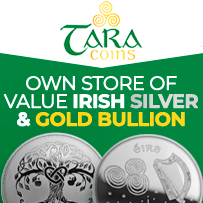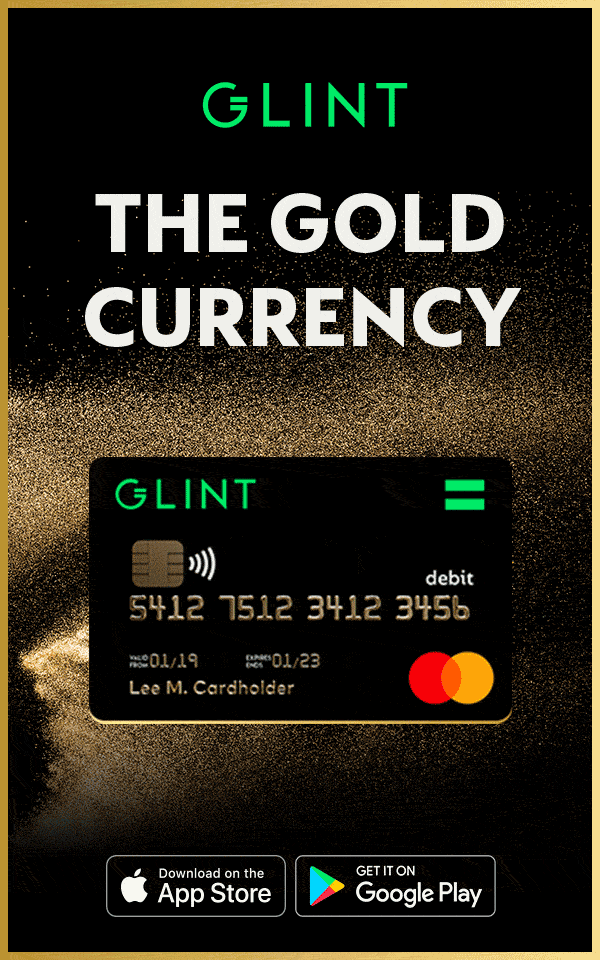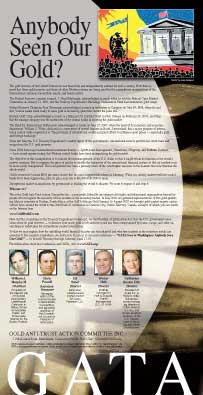You are here
Goldman Sachs runs Treasury under both parties
Yes, $8,000 an Ounce
An Interview with James Turk, Founder of Goldmoney.com
By Sandra Ward
Barron's
Monday, May 29, 2006
Not only did he pinpoint the beginning of the current bull market in
gold in these pages in September 2002, but he has been spot-on in
continuing to assess the direction of the metal and the drivers
behind its move. James Turk, a longtime authority on gold and other
precious metals, is the founder of Goldmoney.com, a company that
enables online cross-border commercial transactions using gold as a
currency. He is also a co-author of "The Coming Collapse of the
Dollar," published in 2004 by Doubleday. As you might surmise from
the title of the book, Turk sees plenty of room for gold to climb
higher. Here's a glimpse into his thinking.
Barron's: You've been right on the price of gold all the way up.
Turk: The theme has been correct. There are problems with the
dollar, and that's being reflected in a higher gold price. So, truth
be told, it's not that gold is going higher -- it's that the dollar
is going lower. An ounce of gold still purchases as much crude oil,
essentially as it did 50 years ago, but that can't be said about
dollars.
Barron's: One of your gold indicators, the "fear index," is based on
M-3 numbers, but the government has stopped reporting M-3.
Turk: Yes, it's really unfortunate. They said the motivation for
doing that was to save the time of reporting it, and they're also
going to save a million dollars in the cost of compiling that data.
I find it quite shocking they would stop reporting M-3, because it
is the most important component of money, revealing the total
quantity of dollars in circulation. My guess is they want to try to
hide the amount of inflation that's in the pipeline. When they
stopped reporting M-3, it was growing at well over 8% per year, and
the annual growth trends were increasing. So I think it was all part
of this policy to control inflationary expectations. But it is a
major misstep because it will end up heightening people's concerns
about the dollar. And that's going to make gold go up.
Barron's: You thought we would have had a dollar crisis by now.
Turk: Yes, but one could argue we have a dollar crisis. If you look
at where the dollar has come in the past few years in terms of loss
of purchasing power, we haven't reached a panic point yet. But I
still fear we are going to see a panic in the dollar at some point
in the future.
Barron's: Let's talk about the pressures on the dollar.
Turk: They are taking on a bit more urgency. One of the things I
picked up on a recent trip outside the States was a much greater
level of concern about the prospects for the dollar than had
previously been the case.
Barron's: Concerns among whom?
Turk: Among sophisticated investors -- wealthy individuals as well
as some money managers. That's been linked to two specific events.
First, Chinese National Offshore Oil Co., or Cnooc, was not
permitted to purchase Unocal. Most people at the time shrugged it
off as just a one-off event. But when the Dubai Ports deal was
blocked, that really changed people's perceptions, because it made
clear holders of dollars outside the United States are not going to
be permitted to exchange those dollars for things of tangible value.
There's an increasing desire to convert dollars into, say,
commodities, which dollars can still buy. The boom in commodities to
a large extent is the result of people exiting dollars. People are
looking for alternatives to the U.S. dollar, and the dollar's role
as the world's reserve currency is being questioned seriously now.
The Russian finance minister raised the issue in the recent G-7
meetings. This questioning is a critical development. Financing the
growing federal budget deficit and trade deficit requires that a
large amount of dollars be created. These dollars are being created
as demand for the dollar is declining.
Turk: The gold standard's greatest attribute was forcing discipline
on the creation of national currencies.
Barron's: How do you measure that?
Turk: You can't really measure it. We talk about M-3, which is the
supply of dollars, but we don't really focus on the demand for
dollars. There is an above-ground stock of gold and an above-ground
stock of dollars, and my fear index measures the relative demand
between the two. The fear index is rising, indicating demand for
dollars is declining. But, anecdotally, the central banks are
diversifying out of the dollar, as are individuals and corporations.
So we know demand for the dollar is falling. The monetary system is
broken.
Barron's: What's broken about it?
Turk: There's no discipline on U.S. dollar creation. The gold
standard's greatest attribute was forcing discipline on the creation
of national currencies; if too much national currency was being
created, gold would flow from one country to another and eliminate
and minimize the impact of the boom- and-bust cycles. The huge trade
imbalances we are seeing now between China and the U.S., and the
U.S. and other countries, never could have existed under the gold
standard. Ultimately, I see capital controls coming to the U.S. as a
way for the government to attempt to deal with these huge trade and
international capital-flow imbalances. Instead of limiting the
amount of dollars in circulation and trying to get us back to some
kind of a disciplined basis, we are probably going to move toward
capital controls as the next step.
Barron's: Any sign of that trend?
Turk: Yes, the fact that the Dubai and Unocal deals were rejected.
Protectionism and capital controls are very closely related.
Barron's: Do you have a new gold-price target?
Turk: It is going much higher, and the $8,000 [per ounce] I
mentioned a couple of years ago is probably as good a target as any.
Barron's: Some reports say $2,000 is reasonable.
Turk: I don't rule that out as a near-term spike. There are two
aspects to what's driving the gold price: First, there is strong
physical demand around the world. When gold crossed the $500-an-
ounce level, people started buying gold in anticipation of monetary
problems. Second, the physical demand for gold is causing a huge
problem for the gold shorts. There has been a large gold carry trade
in place. It is very possible gold could have a massive spike in the
next six to 12 months to as high as $2,000, driven by these factors.
Barron's: Are there any signs of this trouble yet?
Turk: Central banks loaned a lot of gold from their reserves. It was
borrowed by various banks and others for the carry trade. You borrow
gold at very low interest rates and sell it at the spot price. Then
you invest the proceeds in higher-yielding dollars and other
currencies. As long as the gold price doesn't rise, you are going to
make a lot of money on the spread. But in a rising gold-price
environment, you are stuck. You have to buy that gold back or suffer
the consequences of ultimately having to deliver the gold at a much
higher price than what you are earning from your assets. The bullion
banks and others who borrowed it are short. What's happening in gold
is probably even worse in silver, in the sense that the short
position in silver looks even bigger than gold's. Recently, silver
has risen more rapidly than gold.
Barron's: Can this go on indefinitely?
Turk: A lot of people got out of the gold market, expecting a
correction, as often occurs at the beginning of major bull markets.
In December, when gold went over $500 an ounce, I said gold is never
going back below $500, ever. Now we have to think about the
possibility that gold is never going to go back below $600, ever. It
is too cheap and undervalued. I like to draw comparisons to the
1970s when gold went through $50 and never looked back. After Nixon
closed the gold window in August 1971, gold went from $40 to $120 an
ounce in the next two years. Adjusting for inflation, you could
argue $500 today is like $42 in 1971. Multiply $120 by 11 times in
order to get the inflation-adjusted dollar equivalent, and you get a
potential target of more than $1,300 an ounce.
Barron's: What's the relationship between the yield curve and gold?
Turk: The most important thing that affects gold in terms of
interest rates is real interest rates, or rates adjusted for
inflation. I measure this as the fed-funds rate less the CPI
[consumer-price index]. Even though interest rates have risen, real
interest rates remain close to zero, or are negative. John Williams,
an economist, has an interesting Website called Shadowstats.com. He
looks at the CPI and what level it would be at were it not for all
the adjustments in the past 30 years. If the CPI were still
calculated today as it was in the 1970s, the inflation rate would be
about 8%. Depending on how you measure inflation, real interest
rates are no better than zero and probably are negative. That is
very inflationary. What will be negative for gold is when real
interest rates go to 4% or 5%. It took Paul Volcker bringing real
interest rates up to 6%, 7%, 8% in a short period of time before the
market was convinced he was going to save the dollar and it was time
to move out of tangible assets into financial assets.
Barron's: Isn't the government in a bit of a box?
Turk: It is trying to fund the federal budget deficits without
destroying the dollar, and trying to raise interest rates to save
the dollar without destroying the economy. I don't think they can do
it. The dollar will continue to lose purchasing power.
Barron's: Are you recommending any gold stocks?
Turk: Gold stocks are still relatively cheap. In the past several
months, even as the gold price has gone up, the stocks have been
reluctantly following rather than leading, which is contrary to what
normally happens. If I'm correct that the price of gold eventually
goes to four digits, the earnings of gold companies will be
significantly higher. As a consequence, gold stocks are still cheap.
Barron's: What do you say when people wonder if your views are self-
serving because your company, GoldMoney.com, promotes gold as a
currency for transactions?
Turk: My views on the markets are completely separate from my
company. I started the company anticipating that more people would
turn to gold, and I recognized the opportunity from a commercial as
well as an investment point of view.
Barron's: For gold investors, is there much difference between
Bernanke and Greenspan?
Turk: Yes. Bernanke is very different. Greenspan clearly understood
gold, and in his Fed testimony he used to talk about
the "automaticity" of the gold standard. If you go back to
Greenspan's testimonies, you will see him using that word from time
to time. Bernanke doesn't have the deep understanding that Greenspan
had about gold and perhaps about markets in general. Greenspan came
up from the business world, Bernanke came up through academics. That
makes a difference in terms of one's outlook and levels of
experiences.
Barron's: What has Bernanke said or not said that gives you the
sense that he is not fully appreciative of gold?
Turk: It is a combination of what he has written in the past and
what he said prior to his appointment as Fed chairman. He has been
pretty cautious. He has only been chairman for about four months,
but he seems to be focused on the deflation in the 1930s, and this
is quite alarming. What we don't need today is a greater supply of
dollars. What we need is a greater demand for dollars. The way you
improve demand for dollars is to take those steps that will give
people confidence in the dollar and its purchasing power for a long
period of time.
Barron's: Such as?
Turk: Raising interest rates, just as Volcker did, at a pace that is
not measured, but rapid.
Barron's: Wouldn't that come with a lot of pain?
Turk: When you take away the punch bowl, you are left with the
hangover. We have to recognize we've far exceeded our ability to
live at the level at which this country has been living for the past
couple of decades. There is going to be some pain and adjustment.
But if the dollar's purchasing power is destroyed, as a consequence
of not taking strong action the pain is going to be much greater.
Barron's: In what sense?
Turk: When Volcker raised interest rates, we had a severe recession,
but eventually the adjustments led to a period of economic growth,
and we continued to create new wealth from economic activity. When
you create too many dollars in an environment where the demand for
the dollar is declining, it could lead to a situation similar to
Argentina a few years ago or to one that resembles Weimar Germany --
one deflationary and one inflationary. In Argentina, the supply of
pesos declined by one-third from peak to trough, but the purchasing
power of the peso lost 50%. In Germany, demand for the Reichsmark
was falling and the central bank tried to offset that by putting
more Reichsmarks into circulation. Both situations ended badly, and
the net result was severe economic dislocations.
* * *
Gold and Black Gold
Throughout the past 60 years, the price of crude oil in grams of
gold has remained essentially unchanged. The dollar price of crude
has broken out of a 30-year range, suggesting either that oil is
relatively overvalued or that gold is extremely undervalued. In
Turk's view, gold is undervalued and oil is properly valued. As oil
goes higher in dollar terms, he argues, so will gold.
Turk: The problem is the dollar is the world's reserve currency.
What happens when you have a flight from the world's reserve
currency? This is the point of my book, "The Coming Collapse of the
Dollar." The flight from the dollar is going to accelerate. The
dollar has only 5% of the purchasing power it did maybe 50 years
ago.
Barron's: What is the impact of oil on all this?
Turk: Oil is interesting because you have two dynamics. The oil
producers seemingly are less and less willing to take dollars,
because dollars are being depreciated.
Barron's: Where is the evidence of that?
Turk: The Russians are questioning the dollar's role as the reserve
currency. And in Venezuela, when President Hugo Chavez takes a swipe
at the U.S., he is taking a swipe at our ability to create dollars
out of thin air. And as Charles de Gaulle used to say, "deficits
without tears." That's what he finds unacceptable.
Barron's: And the other dynamic?
Turk: The second dynamic is Matt Simmon's argument that we are
running out of easy-to-produce light, sweet crude. If the supply of
easily refinable crude oil is diminishing, all the more reason for
the price of crude oil to rise. So, we have a weakening dollar and a
declining supply of the best-quality crude.
Barron's: And that translates into. ...?
Turk: $100-a-barrel crude oil before too long.
Barron's: And in terms of gold?
Turk: There is a close historical relationship between crude oil and
gold. Normally it takes about 2.2 grams of gold to buy one barrel of
crude oil. Now it takes about 3.4 grams to purchase one barrel of
crude oil. Either oil is relatively overvalued or gold is very
undervalued. My view is gold is undervalued and that oil is properly
valued. So as oil goes higher in dollar terms, gold is going to
continue to go higher, as well.
Barron's: Are exchange-traded funds a positive for gold or a
complicating factor?
Turk: They are positive in the sense that people are looking at gold
and coming up with new products. But I do not recommend people buy
the ETF [streetTracks Gold Shares, or GLD]. If you want to speculate
on the gold price, the ETF is one way to do that. Futures contracts
are another way. But owning the physical metal in your own name is
something entirely different. There are too many parties between you
and the gold in the ETF. And they don't audit the gold to prove it
really exists. This is the only type of fund the SEC has ever
approved for the retail level that isn't required to audit the
assets supposedly backing the fund. It is a great way to speculate
on gold's spot price, just as futures contracts are a great way to
speculate on gold's future price. But neither should be viewed as an
alternative to owning the physical metal.
Barron's: Thanks, James.
----------------------------------------------------
To subscribe to GATA's dispatches, send an e-mail to:
gata-subscribe@yahoogroups.com
To unsubscribe, send an e-mail to:
gata-unsubscribe@yahoogroups.com
Caution: America Online prohibits delivery of GATA
dispatches to AOL e-mailboxes.
----------------------------------------------------
RECOMMENDED INTERNET SITES
FOR DAILY MONITORING OF GOLD
AND PRECIOUS METALS
NEWS AND ANALYSIS
Free sites:
http://www.cbs.marketwatch.com
http://www.usagold.com/amk/usagoldmarketupdate.html
http://www.capitalupdates.com/
http://www.silver-investor.com
http://www.thebulliondesk.com/
http://www.goldismoney.info/index.html
http://www.minersmanual.com/minernews.html
http://www.a1-guide-to-gold-investments.com/euro-vs-dollar.html
http://www.investmentrarities.com
http://www.kereport.com
(Korelin Business Report -- audio)
http://www.plata.com.mx/plata/home.htm
(In Spanish)
http://www.plata.com.mx/plata/plata/english.htm
(In English)
http://www.resourceinvestor.com
http://www.goldpennystocks.com/
Subscription sites:
http://www.lemetropolecafe.com/
http://www.interventionalanalysis.com
http://www.investmentindicators.com/
Eagle Ranch discussion site:
http://os2eagle.net/checksum.htm
Ted Butler silver commentary archive:
http://www.investmentrarities.com/
----------------------------------------------------
COIN AND PRECIOUS METALS DEALERS
WHO HAVE SUPPORTED GATA
AND BEEN RECOMMENDED
BY OUR MEMBERS
Blanchard & Co. Inc.
909 Poydras St., Suite 1900
New Orleans, Louisiana 70112
888-413-4653
http://www.blanchardonline.com
Centennial Precious Metals
Box 460009
Denver, Colorado 80246-0009
1-800-869-5115
http://www.USAGOLD.com
Michael Kosares, Proprietor
cpm@usagold.com
Colorado Gold
222 South 5th St.
Montrose, Colorado 81401
http://www.ColoradoGold.com
Don Stott, Proprietor
1-888-786-8822
Gold@gwe.net
El Dorado Discount Gold
Box 11296
Glendale, Arizona 85316
http://www.eldoradogold.net
Harvey Gordin, President
Office: 623-434-3322
Mobile: 602-228-8203
harvey@eldoradogold.net
Gold & Silver Investments Ltd.
Mespil House
37 Adelaide Rd
Dublin 2
Ireland
+353 1 2315260/6
Fax: +353 1 2315202
http://www.goldinvestments.org
info@gold.ie
Investment Rarities Inc.
7850 Metro Parkway
Minneapolis, Minnesota 55425
http://www.gloomdoom.com
Greg Westgaard, Sales Manager
1-800-328-1860, Ext. 8889
gwestgaard@investmentrarities.com
Kitco
178 West Service Road
Champlain, N.Y. 12919
Toll Free:1-877-775-4826
Fax: 518-298-3457
and
620 Cathcart, Suite 900
Montreal, Quebec H3B 1M1
Canada
Toll-free:1-800-363-7053
Fax: 514-875-6484
http://www.kitco.com
Lee Certified Coins
P.O. Box 1045
454 Daniel Webster Highway
Merrimack, New Hampshire 03054
http://www.certifiedcoins.com
Ed Lee, Proprietor
1-800-835-6000
leecoins@aol.com
Lone Star Silver Exchange
1702 S. Highway 121
Suite 607-111
Lewisville, Texas 75067
214-632-8869
http://www.discountsilverclub.com
MRCS Canada
12303-118 Ave. NW
Edmonton, Alberta T5L 2K2
Canada
http://www.mrcscanada.com
Michael Riedel, Proprietor
1-877-TRY-MRCS
1-877-879-6727
mrcscanada@shaw.ca
Miles Franklin Ltd.
3015 Ottawa Ave. South
St. Louis Park, Minn. 55416
1-800-822-8080 / 952-929-1129
fax: 952-925-0143
http://www.milesfranklin.com
Contacts: David Schectman,
Andy Schectman, and Bob Sichel
Missouri Coin Co.
11742 Manchester Road
St. Louis, MO 63131-4614
info@mocoin.com
314-965-9797
1-800-280-9797
http://www.mocoin.com
Resource Consultants Inc.
6139 South Rural Road
Suite 103
Tempe, Arizona 85283-2929
Pat Gorman, Proprietor
1-800-494-4149, 480-820-5877
Metalguys@aol.com
http://www.buysilvernow.com
Richard Nachbar Rare Coins
5820 Main St., Suite 601
Williamsville, N.Y. 14221-8232
877-622-4227
http://www.CoinExpert.com
nachbar@coinexpert.com
Swiss America Trading Corp.
15018 North Tatum Blvd.
Phoenix, Arizona 85032
http://www.swissamerica.com
Dr. Fred I. Goldstein, Senior Broker
1-800-BUY-COIN
FiGoldstein@swissamerica.com
The Moneychanger
Box 178
Westpoint, Tennessee 38486
http://www.the-moneychanger.com
Franklin Sanders
1-888-218-9226, 931-766-6066
----------------------------------------------------
HOW TO HELP GATA
If you benefit from GATA's dispatches, please
consider making a financial contribution to
GATA. We welcome contributions as follows.
By check:
Gold Anti-Trust Action Committee Inc.
c/o Chris Powell, Secretary/Treasurer
7 Villa Louisa Road
Manchester, CT 06043-7541
USA
By credit card (MasterCard, Visa, and
Discover) over the Internet:
http://www.gata.org/creditcard.html
By GoldMoney:
http://www.GoldMoney.com
Gold Anti-Trust Action Committee Inc.
Holding number 50-08-58-L
Donors of $200 or more will receive copies
of "The ABCs of Gold Investing" by Michael
Kosares, proprietor of Centennial Precious
Metals in Denver, Colorado, and "The Coming
Collapse of the Dollar" by James Turk and
John Rubino.
GATA is a civil rights and educational
organization under the U.S. Internal Revenue
Code and contributions to it are tax-deductible
in the United States.








